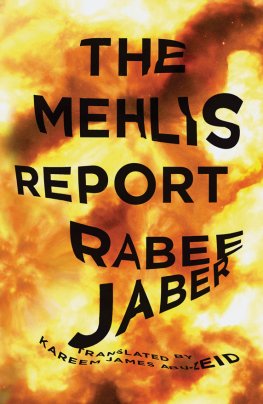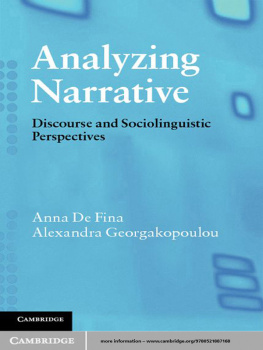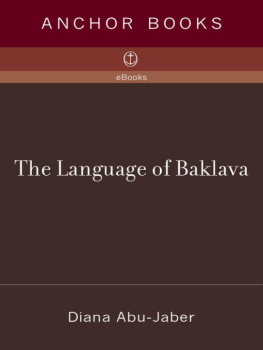Copyright 2009 by SAGE Publications, Inc.
All rights reserved. No part of this book may be reproduced or utilized in any form or by any means, electronic or mechanical, including photocopying, recording, or by any information storage and retrieval system, without permission in writing from the publisher.
For information:
SAGE Publications, Inc.
2455 Teller Road
Thousand Oaks, California 91320
E-mail:
SAGE Publications Ltd.
1 Olivers Yard
55 City Road
London EC1Y 1SP
United Kingdom
SAGE Publications India Pvt. Ltd.
B 1/I 1 Mohan Cooperative Industrial Area
Mathura Road, New Delhi 110 044
India
SAGE Publications Asia-Pacific Pte. Ltd.
33 Pekin Street #02-01
Far East Square
Singapore 048763
Printed in the United States of America
Library of Congress Cataloging-in-Publication Data
Gubrium, Jaber F.
Analyzing narrative reality/Jaber F. Gubrium, James A. Holstein.
p. cm.
Includes bibliographical references and index.
ISBN 978-1-4129-5219-4 (pbk.)
1. EthnographyMethodology. 2. Discourse analysis, Narrative. 3. Storytelling. 4. Oral tradition. 5. Narration (Rhetoric) 6. Participant observation. 7. Written communication. 8. Culture and communication. I. Holstein, James A. II. Title.
GN345.G83 2009
301dc22 2007052846
This book is printed on acid-free paper.
08 09 10 11 12 10 9 8 7 6 5 4 3 2 1
| Acquisitions Editor: | Vicki Knight |
| Associate Editor: | Sean Connelly |
| Editorial Assistant: | Lauren Habib |
| Production Editor: | Sarah K. Quesenberry |
| Copy Editor: | Teresa Wilson |
| Typesetter: | C&M Digitals (P) Ltd. |
| Proofreader: | Theresa Kay |
| Indexer: | Ellen Slavitz |
| Cover Designer: | Glenn Vogel |
| Marketing Manager: | Stephanie Adams |
N arrative analysis crosses several borders. In literary studies, longstanding interest in the organization of stories has dealt with epistemological issues, the structure of folktales, and the shape of characterization, themes, and emplotment, among other organizational matters. Interest has moved into the social sciences and been applied in research projects that utilize stories to understand personal experience as it relates to work, family life, the community, and nationhood, for example. A further crossing enters the domain of rehabilitation and reform. Here narrative analysis features how the restorying of experience can be used to recover from personal ills or to reframe the way we think about disadvantage and social betterment. The narrative landscape is exceptionally broad, and its borders have been porous enough to make for extensive cross-fertilization.
Analyzing Narrative Reality deals with one region of this landscape. Following important contributions in anthropology, communication, folklore, oral history, sociolinguistics, and sociology, the book presents a working vocabulary for making explanatory sense of storytelling practice, the everyday uses of accounts, and the situated shaping of narrative composition. While it draws extensively upon these contributions, the book is innovative in the way it combines analytic sensibilities into a unified framework. Analyzing Narrative Reality targets stories and storytelling as these operate within society. As simple as that may sound, this concern still lurks at the outskirts of narrative analysis. The book locates the concern more centrally in the narrative landscape by laying out its challenges and explanatory utility.
Contemporary narrative analysis in social research has engaged all kinds of accountsformal and informal, written and told. Typically, stories are recorded and analyzed as transcripts or texts. Typically, they are considered mainly for their internal organization. This is hardly surprising, since it has drawn extensively and profitably from the humanities and literary studies. Analyzing Narrative Reality suggests that researchers systematically consider the communicative mechanisms, circumstances, purposes, strategies, and resources that shape narrative production. This requires ethnographic sensibilities, which resonate throughout the book.
Narratives reduced to transcripts are flat, without practical depth or detail, even while textual organization has been shown to relate in important ways to factors such as gender and social status. While portions of a transcript might refer to narrative occasions, the settings of storytelling are often taken for granted or missing. For example, a transcribed story from the workplace might reveal a workers assessment of challenges encountered on the job, but may not tell us much about the settings discursive conventions or the linguistic resources commonly used to construct the challenges. One gets little sense of how people usually talk or dont talk and remain silent about challenges. The issue of what is not uttered or storied as opposed to what is communicated encourages us to consider the surrounding conditions of storytelling. Such information can only be discerned from direct consideration of the storying process within the circumstances in which it unfolds.
Analyzing Narrative Reality targets researchers who are drawn to the study of storytelling in vivo, be they veteran researchers newly interested in narrativity or students learning the trade. It is aimed especially at those who have found text-based forms of analysis lacking in concern for narrative production. The book also should appeal to those interested in social interaction and the diverse contexts of, and situated demands on, communication. It draws extensively on primary and secondary narrative material from a variety of settings to illustrate how researchers can conceptualize and analyze narrative practice across the disciplinary landscape.
The books primary goal is analytic. Most social researchers end up with some form of narrative material in handinterview tapes, transcripts of life stories, field notes of talk and interaction, and personal documents such as letters and diaries. This book presents a way of approaching, viewing, and analyzing this material as it relates to its construction and distribution. Having an analytic mission, it is concerned with how to think about and provide understanding of the storytelling process and the organization of accounts. Explicit analytic guidelines are provided, which lead the way to illustrations of their application. While the book offers suggestions for research procedure, it isnt especially about the nuts and bolts of data collection. Nonetheless, the diverse narrative material presented bears on the entire research enterprise.
Undeniably, Analyzing Narrative Reality













